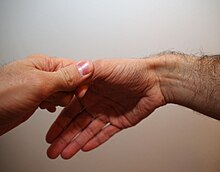


Finkelstein's test is a test used to diagnose de Quervain's tenosynovitis in people who have wrist pain.[1]
Classical descriptions of the Finkelstein's test are when the examiner grasps the thumb and ulnar deviates the hand sharply.[1] If sharp pain occurs along the distal radius (top of forearm, close to wrist; see image), de Quervain's tenosynovitis is likely.[2]
Finkelstein's test is commonly confused with Eichhoff's test:[1] the Eichhoff's test is typically described as the examiner grasping and ulnar deviating the hand when the person has their thumb held within their fist. If sharp pain occurs along the distal radius, Quervain's tenosynovitis is suspected.[3]
Eichhoff's test may produce false positive results, while a Finkelstein's test performed by a skilled practitioner is unlikely to produce a false positive.[4]
- ^ a b c Ilyas A, Ast M, Schaffer AA, Thoder J (2007). "De quervain tenosynovitis of the wrist". J Am Acad Orthop Surg. 15 (12): 757–64. doi:10.5435/00124635-200712000-00009. PMID 18063716.
- ^ de Quervain’s Tenosynovitis: Finkelstein’s Test
- ^ Campbell, William Wesley; DeJong, Russell N. (2005). DeJong's the Neurologic Examination. Lippincott Williams & Wilkins. p. 583. ISBN 9780781727679.
- ^ Goubau, J. F.; Goubau, L.; Van Tongel, A.; Van Hoonacker, P.; Kerckhove, D.; Berghs, B. (2014). "The wrist hyperflexion and abduction of the thumb (WHAT) test: A more specific and sensitive test to diagnose de Quervain tenosynovitis than the Eichhoff's Test". Journal of Hand Surgery (European Volume). 39 (3): 286–292. doi:10.1177/1753193412475043. S2CID 25502297. Archived from the original on May 11, 2014.